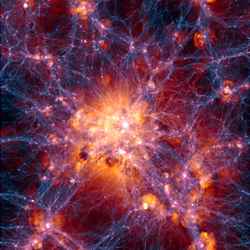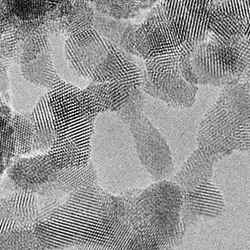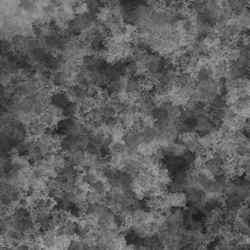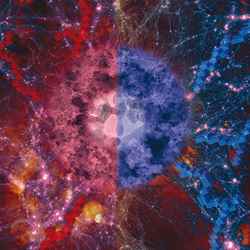Aerogels and the wonders of the universe
Under the covers
In the next of our series on the inspirations behind journal covers, Felix Rechberger, from ETH Zurich, tells us about the connection between aerogel structures and the structure of the universe.
Aerogels are a very special class of solid materials, as they are usually over 95% air. Unlike a foam, however, the pores are open and connected to each other. This allows for a very high surface area and extremely low density. In fact, one gram of this material can have a surface area larger than a tennis pitch!
Its open structure makes it translucent, which is why it is sometimes referred to as “frozen smoke”, and when you hold it in your hand it weighs almost nothing.
Usually, aerogels are made by a sol-gel approach, which is a wet chemical method. The liquid inside the pores of the wet gel then needs to be extracted by supercritical drying, similar to extracting caffeine from coffee, to obtain an aerogel.
However, because the reaction conditions are difficult to control, the samples are usually amorphous as opposed to crystalline. This is of limited use for many applications.
We have tried a different approach, using nanoparticles as building blocks to make an aerogel. We can tune the properties of our nanoparticles in terms of composition, morphology, crystallinity, properties etc, and can then assemble them into a three-dimensionally interconnected network (followed by supercritical drying).
Unique properties
Nanoparticles normally show properties that are uniquely attributed to their small size, but these properties can be conserved within an aerogel in this way. We therefore have a truly nanostructured bulk material, i.e. the special properties of the nanoparticles are conserved in a non-nano material.
It is remarkable that we start off with nanosized building blocks and end up with a centimetre sized aerogel. That is like taking a handful of LEGO® bricks and assembling them into a structure that reaches from the surface of the earth up to the orbit of the international space station! And despite its extremely low density it can support several hundred times its own weight.
We believe the morphological features of aerogels are still far from being fully exploited. The availability of nanoparticles is immense and the compositional variety which we can produce in aerogel form is possibly only limited by imagination. Combined with the large surface area and low density we believe that particle aerogels can make a big impact in the field of gas phase reactions, be it in catalysis or in photocatalysis.
From the art desk
The idea for the cover design came to mind when I saw some simulations of the formation of the early universe.
It turns out that the building blocks of the universe look quite similar to the building blocks of an aerogel, with the gas and matter corresponding to the aerogel structure, and the emptiness of space corresponding to the vacuum of the electron microscope.
I also remembered the famous quote by Mark Miodownik:
“For if ever there was a material that represented mankind’s ability to look up to the sky and wonder who we are, if there ever was a material that represented our ability to turn a rocky planet into a bountiful and marvelous place, if ever there was a material that represented our ability to explore the vastness of the solar system while at the same time speaking of the fragility of human existence, if ever there was a blue-sky material – it is aerogel.”
In addition I wanted to include a reference to everyone’s favourite building blocks – LEGO® bricks!
I obtained some images of universe simulations from The Illustris Collaboration and created the composite image using Photoshop.
I started with an image from Illustris showing dark matter density overlaid with a gas velocity field. From this image I cut out the gas velocity field to enhance the dark matter in the foreground and to make a two-sided image, then added two electron microscope images showing a particle based aerogel, then finally added the LEGO® bricks.
As the nanoparticle assembly allows for different compositions, the image is divided into one side showing blue LEGO® bricks in front of a blue background and the other side showing the same in red.
This article appears on the cover of Nanoscale Horizons today.
Read the paper: Synthesis of aerogels: from molecular routes to 3-dimensional nanoparticle assembly (free to access upon registration)
Press office
- Tel:
- +44 (0) 20 7440 3351
- Email:
- Send us an email




